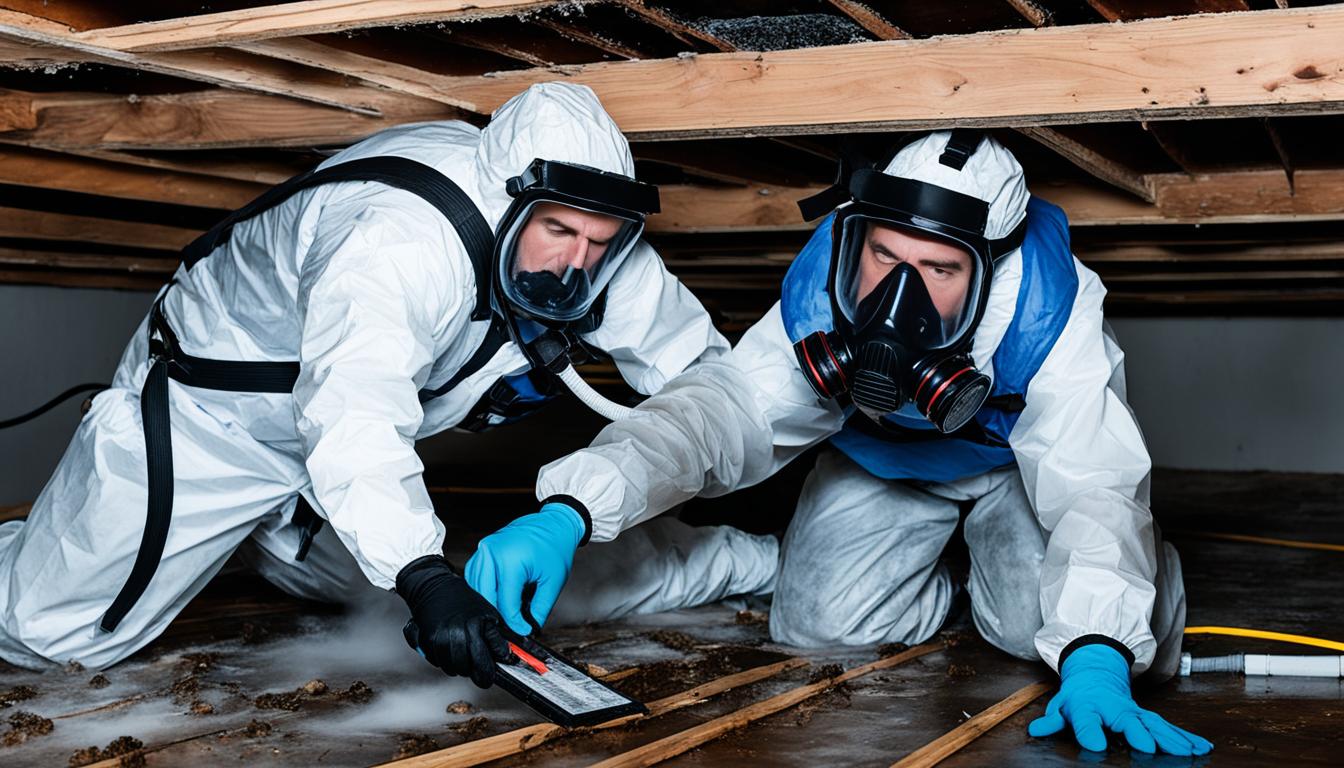
Fix Mold Under House: Proven Remediation Tips
Welcome to our comprehensive guide on fixing mold issues under your house. Dealing with mold can be a challenging task, but with the right knowledge and strategies, you can effectively address the problem. In this section, we will explore various mold removal methods and provide tips for preventing mold growth in the future.
Mold can thrive in damp and dark areas, such as the crawl space or basement of your house. It not only poses health risks but can also damage your property if left unattended. By understanding the signs of mold and implementing the appropriate remediation techniques, you can maintain a safe and healthy living environment for you and your family.
Key Takeaways:
- Learn effective strategies to fix mold issues under your house
- Discover various mold removal methods
- Implement prevention techniques to avoid future mold growth
- Consult professional mold removal services for severe cases
- Regularly inspect and maintain areas prone to moisture and humidity
Signs of Mold in Crawl Space and Dealing with Mold in Basement
If you have a crawl space or basement in your home, it’s important to be aware of the signs that mold may be present in these areas. Mold growth in these spaces can not only damage the structure of your home but also pose health risks to you and your family. In this section, we will explore the common signs of mold in crawl spaces and basements and provide tips for dealing with this issue effectively.
Signs of Mold in Crawl Space
If you suspect mold growth in your crawl space, keep an eye out for these signs:
- Musty Odor: A strong, musty smell is often an indication of mold presence. If you notice a distinct, earthy odor in your crawl space, mold may be the culprit.
- Visible Mold: Inspect the walls, floor, and support beams of your crawl space for any visible signs of mold. Look for patches of discoloration or fuzzy growth, which can indicate mold colonies.
- Water Damage: Mold thrives in damp environments, so any signs of water damage, such as water stains or moisture buildup, may suggest mold growth in your crawl space.
- Allergic Reactions: If you or your family members experience allergic symptoms like sneezing, coughing, or skin irritation when spending time in the home, it could be due to mold present in the crawl space.
If you notice any of these signs, it’s crucial to address the issue promptly to prevent further mold growth and potential health hazards.
Dealing with Mold in Basement
Basements are another common area where mold can thrive due to high humidity levels and poor ventilation. Here are some steps you can take to handle mold in your basement:
- Identify the Source: Firstly, determine the cause of moisture in your basement. It could be due to leaking pipes, improper drainage, or inadequate insulation. Fixing the source of moisture is essential to prevent mold from reoccurring.
- Clean Affected Areas: If you notice small patches of mold growth in your basement, you can attempt to remove it yourself using DIY mold remediation methods. Wear protective gear, such as gloves and a face mask, and use a mixture of water and detergent to clean the affected areas thoroughly. Make sure to dry the area properly to prevent mold spores from spreading.
- Consult Professional Services: For extensive mold growth in your basement or if you have underlying structural issues, it’s advisable to seek professional mold removal services. Certified mold remediation specialists have the expertise and equipment to safely and thoroughly remove mold, ensuring a clean and healthy environment.
Remember, mold removal in crawl spaces and basements should be approached with caution, as improper handling can lead to the spread of spores and costly damages. If in doubt, it’s always best to consult professionals for effective mold remediation.

In the next section, we will focus on mold prevention tips to help you maintain a mold-free environment in your home.
Mold Prevention Tips
Preventing mold growth in your house is crucial for maintaining a healthy living environment. By following these mold prevention tips, you can effectively minimize the risk of mold infestation and protect your home.
1. Keep your house dry: Moisture is the primary factor that contributes to mold growth. Regularly inspect your house for leaks and fix them promptly. Ensure proper ventilation in areas prone to moisture, such as bathrooms and kitchens. Use dehumidifiers in damp spaces to reduce humidity levels.
2. Manage indoor humidity: Maintaining optimal indoor humidity levels (between 30-50%) is essential to prevent mold growth. Use air conditioners and fans to control humidity during humid weather. Avoid drying clothes indoors as this can increase moisture levels.
3. Properly ventilate your home: Good airflow helps to prevent mold by reducing moisture buildup. Open windows and use exhaust fans when cooking or showering. Install vents in moisture-prone areas such as the kitchen and bathroom to allow air circulation.
4. Regularly clean and inspect: Regular cleaning can help prevent mold growth by eliminating potential food sources. Pay special attention to areas with higher moisture levels, such as bathrooms, basements, and crawl spaces. Additionally, regularly inspect hidden areas like attics and behind furniture for signs of mold.
5. Control outdoor vegetation: Keep vegetation, such as shrubs and trees, trimmed away from your house. Overhanging branches and dense foliage can obstruct proper airflow, trap moisture, and create conducive conditions for mold growth.
Remember, prevention is key when it comes to mold. By implementing these simple yet effective mold prevention tips, you can protect your house from mold infestation and maintain a healthy living environment for you and your family.




